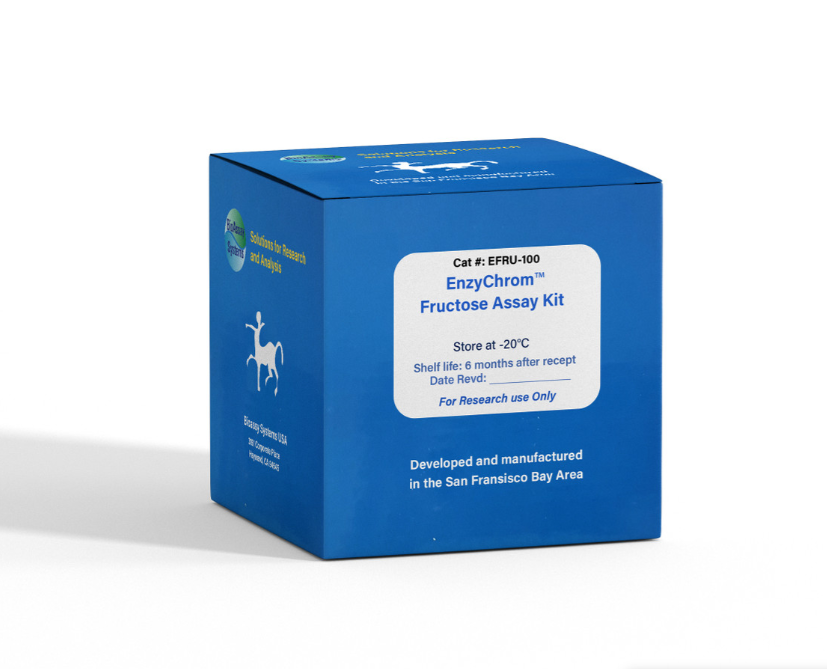DESCRIPTION
FRUCTOSE (C6H12O6, also called levulose or laevulose), is a monosaccharide found in honey, tree fruits, berries, melons, and some root vegetables along with glucose and galactose. The human body can use fructose for energy, however, too much consumption may lead to high triglycerides. Simple, direct and high-throughput assays for fructose determination find wide applications. BioAssay Systems' reagent systems reacts directly and specifically with fructose to form a colored product. Glucose and galactose do not interfere. The color intensity at 565nm is directly proportional to the fructose concentration in the sample.
KEY FEATURES
Use as little as 20 µL samples. Linear detection range in 96-well plate: 12 to 1000 µM fructose.
APPLICATIONS
Direct Assays: fructose in biological samples (e.g. serum, plasma, urine, saliva, milk, culture medium), food, juice, beverage and other agricultural products.
Drug Discovery/Pharmacology: effects of drugs on fructose metabolism.
KIT CONTENTS
Assay Buffer: 10 mL Enzyme: 120 µL
PMS Solution: 1.5 mL MTT Solution: 1.5 mL
Standard: 400 µL 20 mM D-Fructose
Storage conditions. The kit is shipped on ice. Store all components at -20°C. Shelf life of three months after receipt.
Precautions: reagents are for research use only. Normal precautions for laboratory reagents should be exercised while using the reagents. Please refer to Material Safety Data Sheet for detailed information.
ASSAY PROCEDURE
Note: (1) The following substances interfere and should be avoided in sample preparation: ascorbic acid, SDS (>0.2%), sodium azide, NP-40 (>1%) and Tween-20 (>1%). (2) This assay is based on a kinetic reaction. To ensure identical incubation time, addition of Working Reagent to standard and samples should be quick and mixing should be brief but thorough. Use of a multi-channel pipettor is recommended.
Sample treatment: liquid samples such as serum, plasma and fruit juices can be assayed directly. Because fruit juices may contain high concentrations of fructose, it is recommended to dilute juice sample 50- fold (n = 50) in dH2O prior to assay. Milk samples should be cleared by mixing 600 µL milk with 100 µL 6 N HCl. Centrifuge 5 min at 14,000 rpm. Transfer 300 µL supernatant into a clean tube and neutralize with 50 µL 6 N NaOH. The neutralized supernatant is ready for assay (dilution factor n = 1.36).
1. Equilibrate all components to room temperature. Briefly centrifuge the tubes before opening. Keep thawed tubes on ice during assay.
2. Standards: mix 12 µL 20 mM Standard with 228 µL dH2O (final 1000 µM). Dilute standard in dH2O as follows.
Transfer 20 µL diluted standards into separate wells of a clear flatbottom 96-well plate.
Samples: transfer 20 µL of each sample into separate wells of the plate.
3. Color reaction. Prepare enough Working Reagent by mixing, for each reaction well, 56 µL Assay Buffer, 1 µL Enzyme, 14 µL PMS Solution and 14 µL MTT Solution. Keep Working Reagent protected from light. Add 80 µL Working Reagent to each well. Tap plate to mix. Do not expose Working Reagent to light for more than 5 minutes. Incubate 60 min at room temperature in the dark.
4. Read optical density at 565nm (520-600nm). Note: If the calculated fructose concentration of a sample is higher than 1000 µM, dilute sample in water and repeat the assay. Multiply result by the dilution factor n.
CALCULATION
Subtract blank value (water, #4) from the standard values and plot the ∆OD against standard concentrations. Determine the slope and calculate the fructose concentration of Sample,
ODSAMPLE, ODH2O are optical density values of the sample and water. n is the dilution factor. Conversions: 1 mM fructose equals 18 mg/dL, 0.018% or 180 ppm.
MATERIALS REQUIRED, BUT NOT PROVIDED
Pipetting devices, centrifuge tubes, clear flat-bottom uncoated 96-well plates, optical density plate reader.
LITERATURE
1. Novelli G, Reichardt JK. (2000). Molecular basis of disorders of human fructose metabolism: past, present, and future. Mol Genet Metab. 71:62-65.
2. Pudek MR et al. (1990). Low concentration fructose determination in plasma adapted to the Cobas-Bio. Clin Biochem. 23:221-223.
3. Gabrielli M. (1978). Serum fructose determination with centrifugal analyzers. Clin. Chem. 24:1990-1995.
